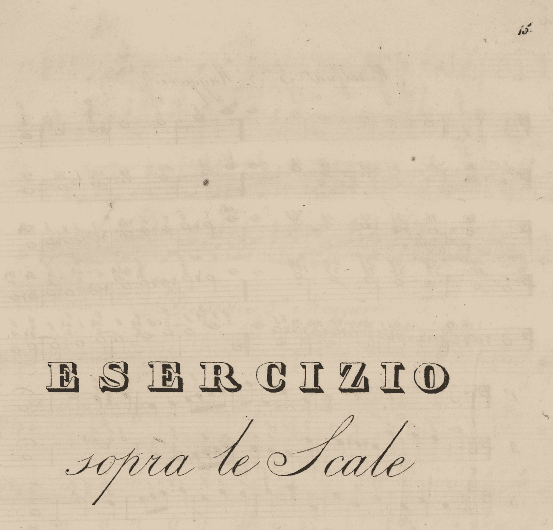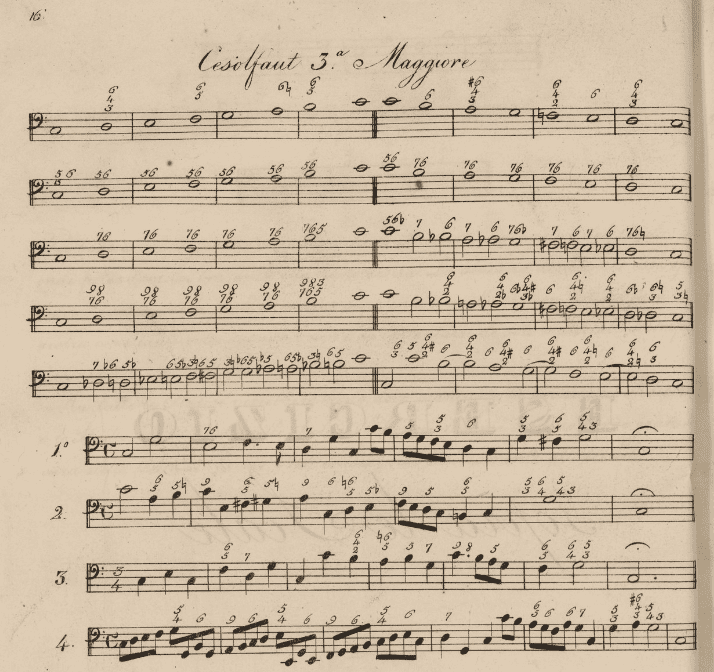The 100 versetti —versets— by Stanislao Mattei are a remarkable collection of short partimenti as part of his treatise Pratica d’accompagnamento. While the length of many partimenti can be intimidating, Mattei’s versets are so concise that they are easily accessible and memorizable.
The 100 versets by Mattei are probably intended to be realized in three parts with great concern for contrapuntal quality, imitation, diminution and variation. As historical evidence shows, instead of presenting one realization, students had to discover as many versions as possible.
In this essay I deal with the collection of 100 versets in its entirety. The individual versets are discussed in individual essays.
Who Was Stanislao Mattei?

Padre Stanislao Mattei (1750–1825) was an Italian monk, composer, contrapuntist and music teacher. Today, he is mainly known as one of the foremost students of and successor to Padre Giovanni Battista Martini (1706–1784), both of whom lived and worked in Bologna.

Amongst Mattei’s students are some illustrious names: Gaetano Donizetti, Gioacchino Rossini and Christian Theodor Weinlig (1780–1842), who taught Richard Wagner and Clara Schumann.
The Treatise Pratica d’Accompagnamento by Stanislao Mattei
One year before his death, in 1824, Mattei published his treatise Pratica d’accompagnamento sopra bassi numerati e contrappunti a più voci sulla scala ascendente e discendente maggiore e minore con diverse fughe a quattro e 8. It consists of two parts and is a modified and expanded version on an autograph from 1788 that dates from the beginning of his teaching career (I-Bc UU.10).
This is the title page of the 1824 edition:

The complete edition can be downloaded via:
https://imslp.org/wiki/Pratica_d%27accompagnamento_sopra_bassi_numerati_e_contrappunti_(Mattei,_Stanislao) or https://opac.sbn.it/risultati-ricerca-avanzata/-/opac-adv/detail/MUS0255463?
The 1788 autograph can be consulted here:
http://www.bibliotecamusica.it/cmbm/viewschedatwbca.asp?path=/cmbm/images/ripro/gaspari/UU/UU010/
This is how part one of the treatise is structured:
- Breve Teoria sull’accompagnamento della Scale : a brief introduction on how to realize scales.
- Esercizio sopra le Scale : in this section appear the 100 versets; more on them below.
- Bassi numerati con analoghe Cadenze preparatorie : Mattei has written four extended partimenti in each major and minor key, each of which is introduced by a tiny partimento he calls a “Cadenza”. These “Cadenze” do indeed strongly resemble the versetti of the previous section; most of them are only four bars long in 4/4 (there are four exceptions).
- [Without title]: a section on modulations.
The bulk of the second part of Pratica d’accompagnamento are an important number of two-, three-, four-, five-, six-, seven- and eight-part contrapuntal settings of ascending and descending scales in major and minor. These settings are preceded by a theoretical introduction on counterpoint and followed by a limited number of settings of chromatically ascending and descending scales.
The Term Accompagnamento
Important to note is that the term accompagnamento does not imply that this treatise is intended to help students how to accompany, how to play basso continuo. Rather, this term should be interpreted in relation to the upper voices that ‘accompany’ the given bass. In other words, the basses in this treatise are intended as pedagogical road maps for the improvisation of keyboard pieces and not as basso continuo parts.
The Esercizio sopra le Scale, Including the 100 Versetti

As its title indicates, the second section of the first part of Mattei’s treatise presents exercises on how to set scales. These come in two forms, both covering all major and minor keys:
- as plain exercises in whole and half notes exclusively on scales
- in the form of short partimenti ranging from only 5 to 12 bars.
Most of these short partimenti (in the 1788 autograph, amongst others, they are labelled versetti) have a similar structure: they open with a moto del basso —a sequential pattern— that is followed by a cadential progression that often concludes with a cadenza composta —a final cadence with two sonorities on ⑤— or a cadenza doppia —a final cadence with four sonorities on ⑤ (For more information on these cadences see my essay Cadences: The Basics.)
There are four versetti per key, which are preceded with five settings of diatonically and chromatically ascending and descending scales in the same key. (In the 1788 autograph, a greater number of settings of ascending and descending scales per key is included.) Incidentally, the reason the total number of versets is 100 instead of 96 is that Mattei included four versets in A flat minor and another four in G sharp minor.
Below you can see all the exercises in C major:

Texture, Style and Outcome
An important influence on the Bologna school of partimento are the trio sonatas by Arcangelo Corelli (for more information see Peter van Tour’s edition of Martini’s Libro per accompagnare). That a three-part texture is most likely what Mattei envisioned for his versetti seems confirmed by two of his own intavolature —partimento realizations for keyboard— of his basses. (These intavolature are included in the Wessmans edition of Mattei’s versetti (Visby: Wessmans Musikförlag, 2021).) Interestingly, these basses are also realized by Mattei in four parts in the 1788 autograph, yet are specifically set there for two violins, viola and bass. (These settings, along with all the four-part settings of the 1788 autograph, are posthumously printed in 1850 with the title Bassi Numerati per accompagnare. Ridotti ad intavolatura a due Violini e Viola. Note that the more common word for contrapuntal exercises written out in a score was disposizione, while intavolatura was reserved for a two-stave keyboard realization.) A three-part texture on the keyboard was indeed considered an ideal balance between vertical clarity on the one hand and melodic and contrapuntal refinement on the other hand.
The autograph of the three-part intavolature, included in the Ricasoli Collection (US-LOu RicS 75a), can be downloaded via:
https://imslp.org/wiki/4_Pieces_for_Organ_(Mattei%2C_Stanislao)
The posthumous 1850 edition can be downloaded via:
https://books.google.be/books/about/Bassi_numerati_per_accompagnare.html?id=bttFAQAAMAAJ&redir_esc=y
From the pedagogical material by Mattei and his master Martini becomes clear that contrapuntal quality, imitation, invertible counterpoint, diminution and variation were essential to the musical training of their students. While only two of Mattei’s versetti hold explicit reference to imitation (numbers 3 and 4 in F sharp minor, numbers 91 and 92 in the Wessmans edition; see the example below), imitational possibilities are abundant within the complete corpus of versetti and should be explored.

While most music theory teachers today would be happy if a student brought one beautifully realized exercise, 18th-century Italian standards were quite different. Students that were allowed to the counterpoint class, which turned automatically and gradually into the composition class, were to become composers and therefore needed to be trained in the most complete way to be able to sustain that type of professional life. The surviving counterpoint books written by those students illustrate that not one but as many versions as possible of a certain exercise needed to be produced. Some of the techniques that contribute to the creation of all these versions are:
- Diminution: This is a technique that in essence transforms long(er) note values into groups of smaller note values.
- Imitation: Students were expected to come up not only with versions set with beautifully written lines but also with versions in which imitation played a central role.
- Invertible counterpoint: This is another important aspect of contrapuntal skills and options.
- Suspensions: An important technique to make a setting more compelling is the use of suspensions. This is often done when a bass note lasts longer than one beat, a technique of which the foundations were laid at the beginning of the partimento training when the student had to learn the basic cadences, some of which include suspensions. (The type of cadence depends largely on the length of ⑤. When it lasts longer than one beat, dissonance(s)/suspension(s) is/are included. For more information see my essay Cadences: The Basics.)
- Chromaticism: A diatonic fragment can often be ‘spiced up’ by adding chromatic half steps, possibly but not necessarily resulting in brief, temporary changes of key.
- Reharmonization: Possibly but not necessarily related to the previous technique, reharmonization is another technique to come up with multiple versions of a setting.
Because the day-to-day methods of partimento teaching —what type of assignments did partimento students actually had to do?— remain shrouded in mystery to a large extent, applying this counterpoint-class methodology to partimento can help us to unveil some of the mystery. Two of the techniques described above require further consideration specifically in relationship to partimenti:
- Diminution: Even if the bass of a partimento is given, one should not shy away from adding diminutions to it if this enriches the contrapuntal fabric, if this manipulation makes the contrapuntal fabric more coherent.
- Invertible counterpoint: Regarding three-part partimenti, this implies investigating if one can swap the upper and middle voices so that the setting remains both contrapuntally correct and sufficiently comfortable to play, which is often the case.
Of all the partimenti and partimenti collections I know, I find Mattei’s 100 versets, thanks to their brevity and intrinsic quality, particularly suitable for learning practical counterpoint with all its patterns and rich voice-leading possibilities, for developing a composer’s mind and for discovering as many versions as possible.
Select Bibliography
Demeyere, Ewald. Cadences: The Basics.
Martini, Giovanni Battista. Libro per accompagnare (1737–38), ed. Peter van Tour (Visby: Wessmans Musikförlag,2020).
Mattei, Stanislao. Pratica d’accompagnamento sopra bassi numerati e contrappunti a più voci sulla scala ascendente e discendente maggiore e minore con diverse fughe a quattro e 8 (1824).
Mattei, Stanislao. Scale, Versetti, Bassi numerati per accompagnare, ridotti ad intavolatura a due violini e viola; come pure Contrapunti a 2. 3. 4. 5. 6. 7. 8. voci sopra la scala ascendente e discendente, con diversi modi di passare da un tono ad un altro (1788; I-Bc UU.10).
